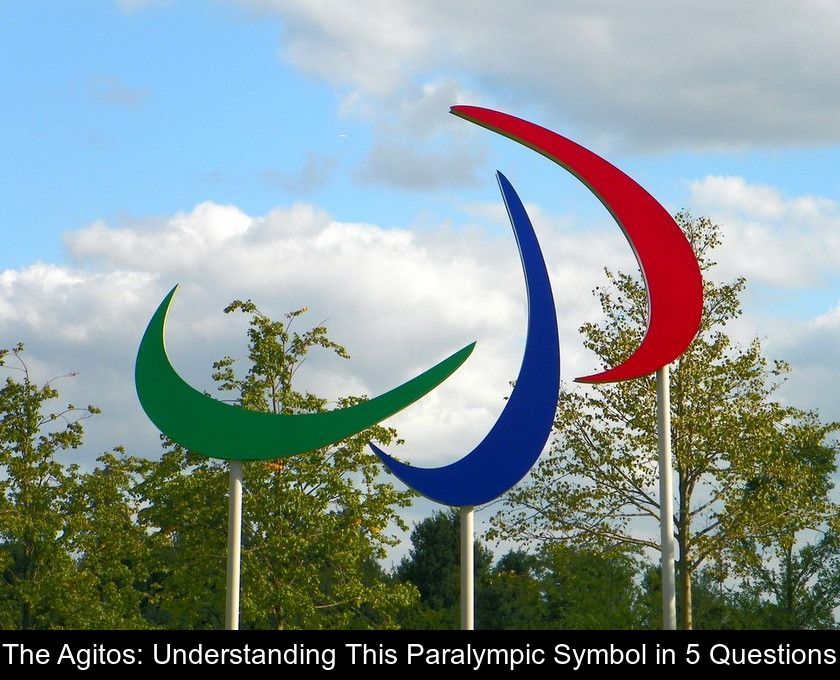The Agitos: Understanding This Paralympic Symbol In 5 Questions
As the opening ceremony is set to take place tonight at Place de la Concorde, marking the start of the Paris 2024 Paralympic Games, the Arc de Triomphe has been displaying these colorful commas that symbolize the Paralympic movement for the past two months: the Agitos! Here is a brief overview to understand this symbol in 5 questions.
1- What are the Agitos?
During the Paris 2024 Paralympic Games and during tonight's opening ceremony, you will likely hear the term "Agitos" repeatedly.
For those who don't know what this peculiar word refers to, the Agitos are the Paralympic symbol featured on the logo and the flag of the Paralympic Games.
This symbol, composed of three large red, blue, and green commas, currently adorns the Arc de Triomphe in Paris, just as the Olympic rings adorn the Eiffel Tower...
2- What is the meaning of the Agitos?
Even though the Agitos are much less known to the general public than the Olympic rings designed by Pierre de Coubertin in 1913, they also have a strong symbolic value.
Their name, which comes from Latin, means "I move" and their shape represents this idea of movement, in line with the Paralympic motto "Spirit in Motion."
As for their colors, there are three (red, blue, and green), but they were not chosen at random. These are the three most represented colors on national flags worldwide.
The Paralympic Committee also explains that the imaginary central point connecting the three Agitos symbolizes the gathering of athletes coming to compete from all corners of the globe.
3- Since what year have the Agitos existed?
This symbol of Paralympism is relatively recent, as it only appeared in 2004 during the closing ceremony of the Athens Paralympic Games.
When the first official Paralympic Games were organized in Rome in 1960, this event had neither a visual identity nor a logo. It was not until 1988 that the International Paralympic Committee or IPC adopted an official visual representation.
That year, the Paralympic Games were held for the first time in the same city as the Olympic Games: in Seoul, South Korea... This likely explains why the Paralympic Committee was inspired by the tae-geuk, a South Korean motif appearing in red and blue on the country's flag.
The first Paralympic symbol, used from 1988 to 1994, had the same configuration and colors as the Olympic rings. From 1994 onward, this symbol differentiated itself from the Olympic rings by reducing the number of shapes to three, to illustrate "Spirit, Body, and Soul," which was the Paralympic motto from 1992 to 2003.
Ten years later, the Korean motif was abandoned in favor of the Agitos, but the three colors were retained. The most recent modification dates back to 2019, when the shape and color of this Paralympic symbol were slightly revised.
4- What are the other symbols of the Paralympic Games?
The Agitos are not the only difference between the Olympic Games and the Paralympic Games. As we mentioned earlier, the Paralympic movement has its own motto (Spirit in Motion), which is very different from the Olympic Games' motto (Faster, Higher, Stronger - Together).
The Paralympic Games also have their own anthem. The Anthem of the Future was composed by Frenchman Thierry Darnis and written by Australian Graeme Connors. This anthem, which is played during the raising of the Paralympic flag at the opening ceremony, was commissioned by the International Paralympic Committee in 1996.
5- Why are the Paralympic Games symbols different?
As the Paris 2024 Paralympic Games are about to begin, you might be wondering why this competition does not use the same symbols as the Olympic Games. Although these two events are now organized in parallel, in the same cities and venues, their origins are different.
The birthplace of Paralympism is not in Olympia, Greece, but in Stoke Mandeville, in a military hospital in northern London. It was there that a German neurologist named Ludwig Guttmann organized the first World Games for paraplegic patients in 1948.
Because there is a half-century gap between the revival of the modern Olympic Games in 1896 and the emergence of the Paralympic movement, each of these two events has its own organizing committee, codes, and symbols.











